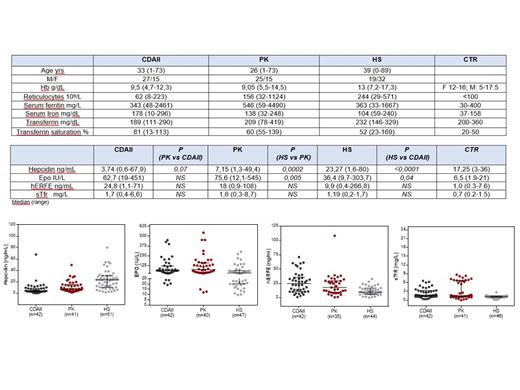Abstract
Iron loading anemias are characterized by ineffective erythropoiesis and iron overload. This group of anemias includes thalassemia syndromes, congenital dyserythropoietic anemias (CDA), and some forms of congenital hemolytic anemias. Among them pyruvate kinase deficiency (PKD) has been shown to develop iron overload also in absence of transfusions suggesting dyserythropoietic features. Moreover, severe forms can be misdiagnosed as CDA due to bone marrow abnormalities and ineffective erythropoiesis further supporting this evidences. The hormone erythroferrone (hERFE) is produced by erythroblasts in response to erythropoietin (EPO), and acts by suppressing hepcidin, thereby increasing iron absorption and mobilisation for erythropoiesis demand. The ERFE-hepcidin axis seems to play a crucial role in the pathogenesis of these disorders; an increased erythroferrone release by immature erythroid cells results in hepcidin suppression and secondary iron overload that could finally results in ineffective erythropoiesis and anemia.
To investigate the pathophysiological basis of iron overload in PKD, we analysed the levels of hERFE, EPO, hepcidin, and soluble transferrin receptor (sTFR) in a large group of 41 PKD patients equally distributed by gender, age and severity. The results were analysed in comparison with two groups of patients affected by hemolytic anemia with overt dyserythropoiesis (42 patients with CDA type II) and with congenital hemolytic anemia due to RBC membrane defects (51 patients with hereditary spherocytosis [HS]), respectively. Demographic, hematologic, and biochemical features of the three groups of patients are reported in the table.
Among the PKD patients, 18/41 were <18 yrs, median Hb level at the time of the study was 9.05g/dL (range 5.5-14.5), 12 underwent splenectomy, 28 ever received at least three transfusions their life, 14 of them transfusion dependent (>6 tx/yrs). Mean ferritin levels at the time of the study were 546 ng/ml (range 59-4990), 15/41 patients requiring chelation therapy for iron overload developed also in absence of transfusions. As expected, CDAII patients showed decreased hepcidin levels (3.74 ng/mL; n.v. 17.25, P<0.001) associated with increased erythropoietin (62.7 IU/L, n.v. 6.5, P=0.01) and hERFE (24.8 ng/mL, n.v. 1, P<0.0001). On the contrary, HS showed increased hepcidin, with less marked increased of ERFE (9.9 ng/mL, P=0.02) and EPO (36.4IU/L, P=0.005). In PKD patients we observed decreased hepcidin levels (7.15 ng/mL, P=0.03)), increased hERFE (18ng/mL, P<0.0001) and EPO (75.6 IU/L, P=0.009). Instead, sTFR was equally increased in the three groups of patients (Figure). Interestingly, by comparing the three groups of patients, PKD showed dyserythropoietic features as evidenced by the observation of intermediate values between HS and CDAII of hepcidin (P=0.007 PKD v CDAII and P=0.0002 PKD vs HS), hEFRE, and sTFR.
This study provides the first analysis of the main regulators of systemic iron homeostasis in PK deficiency compared either with the model of a structural RBC defect (HS) or with the typical model of dyserythropoietic anemia with ineffective erythropoiesis, such as CDAII. These data provide evidence of the dyserythropoietic features of PK deficiency, underlining the need of accurate diagnosis and paving the way of novel therapeutic approaches in PK deficiency.
Zaninoni A. and Russo R. equally contributed to the study
Fattizzo: Kira: Speakers Bureau; Alexion: Speakers Bureau; Novartis: Speakers Bureau; Momenta: Honoraria, Speakers Bureau; Annexon: Consultancy; Apellis: Speakers Bureau; Amgen: Honoraria, Speakers Bureau. Barcellini: Incyte: Membership on an entity's Board of Directors or advisory committees; Novartis: Honoraria; Bioverativ: Membership on an entity's Board of Directors or advisory committees; Agios: Honoraria, Research Funding; Alexion Pharmaceuticals: Honoraria. Iolascon: Bluebird Bio: Other: Advisory Board; Celgene: Other: Advisory Board. Bianchi: Agios pharmaceutics: Consultancy, Membership on an entity's Board of Directors or advisory committees.


